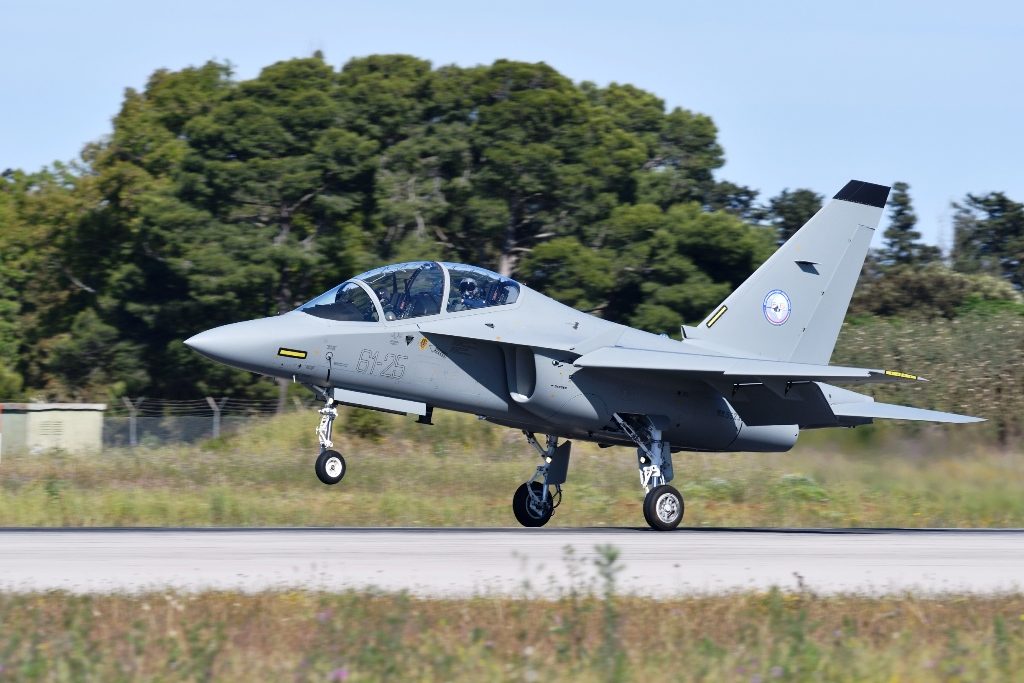
PAS19: IFTS will make Decimomannu the future Advanced Training centre of excellence
Eleven months after the signature of the collaboration agreement between Leonardo and the Italian Air Force for the establishment of the International Flight Training School, new details emerged at a briefing held in the Leonardo static area at Le Bourget. Giuseppe Recchia, VP Training, Leonardo Aircraft Division, and Col. Luigi Casali, Chairman of the IFTS Programme Office, provided in-depth details on the current situation as well as on the future of the IFTS programme.

Currently three IFTS T-346 aircraft are based at the Galatina Air Force Base, home of the 61st Training Wing, the Air Force having completed the training of the first two civil instructor pilots, four more being trained. Many of those are coming from the Italian Air Force, although the position is open to foreign personnel, a French former military pilot being part of the six. “The Italian Air Force will maintain the control over the final product,” Col. Casali tells EDR On-Line, “as we are defining the requirement for being accepted to the qualification course, we are part of the selection process, and we control the IFTS training syllabus.” When the IFTS programme will reach the FOC the aim is to have 40% Italian Air Force instructor versus 60% civil instructors. The first IFTS training course should start in late 2019, no indication being yet available if this will target a European or a Middle East “customer”.

Looking further ahead, the IFTS Step 2 will see the Phase IV – Phase V training, the one performed with the T-346, being moved to Sardinia, on the Decimomannu Air Force Base, located in the south of the island, home of the RSSTA (the Italian acronym for the Italian Air Force Aerial Firing Standardization Experimental Unit) which is also the home of the ACMI (Air Combat Manoeuvring Installation). The Decimomannu base was identified as the optimal location due to a number of reasons. First it is equipped with two runways, which helps to support high training volumes, while the weather is favourable to flight operations for most of the time. Close to the base there are air-to-air and air-to-ground live firing ranges allowing advanced training missions, while a dedicated airspace favours advanced training operations. Last but not least, the base is used to host numerous multinational exercises, which gives the opportunity to merge the IFTS training activity with the ongoing manoeuvres.

The T-346 allows carrying out Live Virtual Constructive (LVC) training, which is part of the syllabus, the latter having been developed following a modular approach: it is made of a standard set that all trainees have to follow, to which modules are added, those being selected by nations according to their needs. The LVC is an area with considerable growth potential, in 2018 a number of different platforms having been linked, the federation of existing simulations having also been tested. To be capable to host the IFTS the base will undergo a full modernisation, a new maintenance and logistic centre being built, including new maintenance hangars and a new flight line dedicated to the IFTS aircraft.

Facilities will be built to host the ground based training system, which will include spaces for the simulators, two full mission simulators and two part task simulators being currently on order, classrooms and office for the IFTS staff. An area will be dedicated to accommodation, 100 apartments being planned together with a canteen and an Air Force Club, as well as sports facilities including a gymnasium and a swimming pool. The infrastructures are designed to cope with increasing training capabilities.

When reaching its FOC the IFTS will see deployed 22 T-346, with around 40 instructors, and will be capable to provide Phase IV courses to over 70 pilots per year, for a total of more than 8,000 flight hours. It is to note that the Italian Air Force is already providing training to numerous other nations, 50 individuals from nine countries being currently in Galatina to follow pilot or instructor pilot courses. The IFTS staff is in contact with numerous other nations, mostly Europe an and from the Middle East, which are interested in the Italian initiative.
The plan is to move the Phase IV to Decimomannu by 2021, considering that in 2020 the T-345 trainer will start being deployed to Galatina, consolidating the Basic Training Centre of Excellence that will carry out Phase II and Phase III training. According to IFTS responsible, the FOC will be reached quite fast once the IFTS will move to Sardinia.
Photos and viewgraphs courtesy Leonardo



